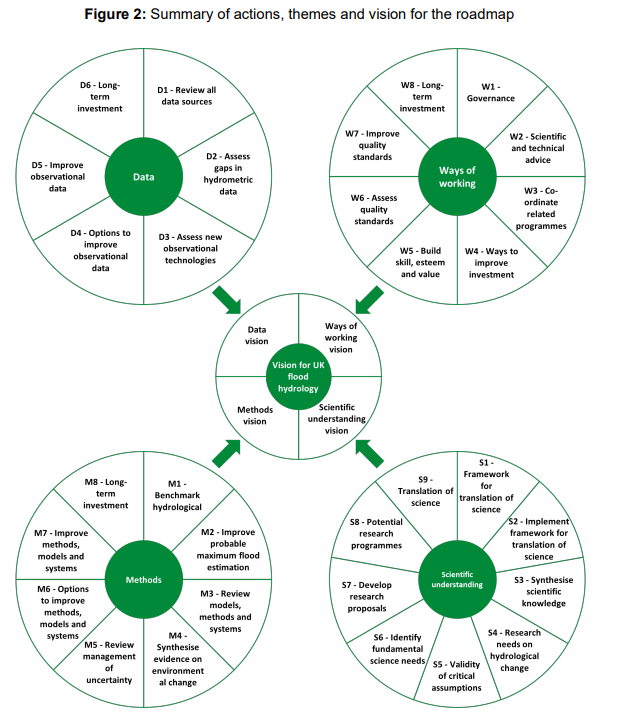Flood Hydrology Road Map – The next 25 Years
The Environment Agency (EA) has published its roadmap for developing flood hydrology for the next 25 years.
This is a critical piece of research as hydrology underpins the estimation of flooding within flood models and influences the flood outlines and flood responses that will be required for the coming years.

The EA is committing up to £165 million over the next 25 years to improve hydrological methods using 31 ‘actions’ grouped into:
-
ways of working
-
data
-
methods
-
scientific understanding

The EA states that “flood hydrology underpins billions of pounds’ worth of investment and activity in flood risk management across the UK,” from the design of flood defences to the insurance industry underwriting, flood modelling, and reservoir safety.
Hydrology is a critical component of flood modelling and is probably the most uncertain component in terms of its overall accuracy as it can be highly subjective.
Thoughts On The Flood Hydology Roadmap
While investment in flood hydrology estimation is welcomed, the size of the investment over 25 years pales in comparison to the flood risk industry as a whole (£2.6 billion over the last 6 years alone).
Given the importance of accurate hydrology as an underpinning of accurate flood prediction, defence design, SuDS design, and all aspects of the water cycle, the level of investment is sadly low. Hydrological estimation is also crucial to the accurate sizing of defences, investment, and risk parameters.
The hydrological space requires significant investment in improving the underlying data upon which the FEH methodologies are built – it is perhaps time to stop building on top of out-of-date data by adding further statistical chicanery, and rather invest in the underlying problems with that data.
Moreover, rainfall runoff modelling is only mentioned once as an alternative method worthy of investigation.
With the advent of faster GPUs, this is a viable alternative to traditional flood estimation IF we can get enough data together to validate the predictions (something that is hard when ground and soil data are held behind significant paywalls).
It would be good to see some of these data sets being made available to hydrologists and flood modellers in a more accessible, preferably freely available format, so that we can use the data to drive value in the rainfall runoff modelling space and deliver calibrated, validated models using real-world data.
This is part of the EA’s vision for data:
-
new and historical data are communicated and shared openly,
-
properly archived and centrally located to support all flood hydrology studies
-
data are freely available for all carrying out flood hydrology studies
So, What Is The Plan Here?
The EA has highlighted several critical avenues for realising their vision.
One of the key ones, in my view, is their idea to “consider how community accessibility (with the aspiration of open and free access) to software could be improved” and the delivery of “improvements to models, methods and systems would enable better uptake of (existing) scientific advances”.
However, there are significant hurdles to overcome here as well, such as the lack of well-publicised or publicised Refh2 methodologies and the requirement of paid usage to implement them in flood models.
FEH methods through WINFAP are also paid to use. Catchment data from the FEH web are priced so that small enterprises pay more for the same data as large companies through the credit system. To truly improve hydrological estimation, it requires open access for all and the ability to share data, techniques, and tools across the industry without meeting paid walls.
It will be interesting to see how this vision develops and what steps can be practically taken to improve flood hydrology in the UK.
EA Flood Hydrology Road Map: Summary
The Environment Agency’s 25-year Flood Hydrology Road Map outlines a significant, though arguably underfunded, commitment to improving flood modelling through better data, methods, and accessibility.
While the roadmap marks positive progress, challenges remain around data availability, transparency, and the adoption of innovative modelling techniques like rainfall-runoff.
At Aeagea, we stay at the forefront of these developments to deliver accurate, insight-driven flood risk assessments.
Find out more about our flood risk assessment services.
Request your free, expert quote now
Aegaea work alongside home owners, private developers, planning consultants, architects, local authorities, international development agencies and contractors. Aegaea know exactly how to help you.